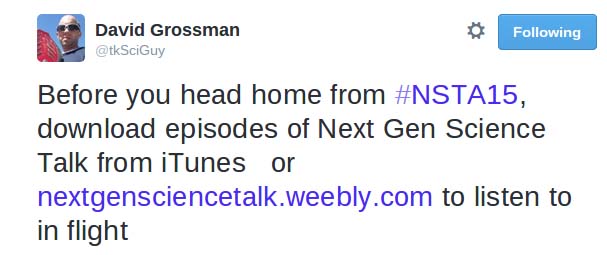It's All About the Hashtag for @2footgiraffe
By Guest Blogger
Posted on 2015-03-16
Hi, Social Media at NSTA? Oops, I mean #NSTA. Double oops, I mean #NSTA15. It’s all about the hashtag. Want to see what happened at #NSTA15? Well, go to Twitter, Instagram, or Vine and search the hashtag. Yes, there are pictures and funny videos being shared. However, there is much more than images and jokes. Sharing through social media can be powerful even if you only have 140 characters.
Twitter: Did you know some of the talks about the Next Generation Science Standards (NGSS) are on iTunes? Thanks to David Grossman @tkSciGuy I now know.
 Instagram can be used to document learning, share images with unlimited space for captions, and even record 15 seconds of video. Scott Sowers (cosmicdebris) got some awesome images from Chicago, like the one to the right.
Instagram can be used to document learning, share images with unlimited space for captions, and even record 15 seconds of video. Scott Sowers (cosmicdebris) got some awesome images from Chicago, like the one to the right.
Vine is a social media tool that can to time lapse-video and 6.5 second power clips. Check out this hypnotic jellyfish vine from EiC. Six seconds may not seem like a lot but check out what you can do.
As you can see from the social media posts above, connections, resources, and ideas are being shared. There is no limit to the potential of social media.
What about for education? Yes! Social media can be used to help teachers and students learn, communicate, and collaborate. As a science teacher I have found Twitter to be incredibly beneficial when trying to connect with experts outside the physical structure of the school. Students and I have connected with shark scientists, physicists, herpetologists, mammalogists, cancer researchers, microbiologists, and volcanologists. I can list a dozen more. It is difficult for scientists to get out of the lab and visit the classroom. Especially if the lab, research location, or field site is thousands of miles away. Twitter can bridge that gap which can then lead to other options like video conferences through Google Hangouts On Air or Skype.
Once in a while these connections lead to more than just conversations. My colleague Tricia Shelton @tdishelton had a student receive funding from one of the science groups for a research project as a result of connections through social media. This particular connection was the result of a monthly Twitter chat called #SciStuChat—details at scistuchat.com. The second Thursday of each month we host an organized discussion with high school students and scientists. Student moderators write the questions for a chosen topic. Students and scientists join together to answer the questions. Scientists also help dispel misconceptions. Sometimes the conversations between scientists and students will continue the next day depending on questions students generate after the hour chat.
There isn’t a PG-rated app that can’t be used for education (i.e., every PG-rated app can be used in education in some way). Yes, a teacher might need to get creative but that is part of the challenge. Twitter, Vine, Instagram are a few examples.
If you are skeptical go to twitter.com/search then look up some of the people on this list of scientists. After some investigation, if you feel Twitter might have value in your classroom or for you personally, then check out www.connectthinklearn.com/connected-educator-support.html for support. You can also visit www.ngsspln.com/ngsschat.html.
Author Adam Taylor teaches at Dickson County High School; reach him on Twitter @2footgiraffe.
To see more from the 2015 National Conference on Science Education in Chicago, March 12-15, please view the #NSTA15 Facebook Album—and if you see yourself, please tag yourself!
The mission of NSTA is to promote excellence and innovation in science teaching and learning for all.
Future NSTA Conferences
2015 STEM Forum & Expo
2015 Area Conferences
Follow NSTA
Disclaimer: The views expressed in this blog post are those of the author(s) and do not necessarily reflect the official position of the National Science Teaching Association (NSTA).




